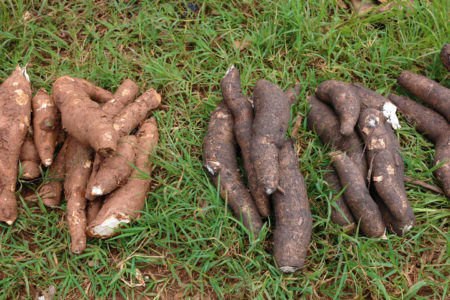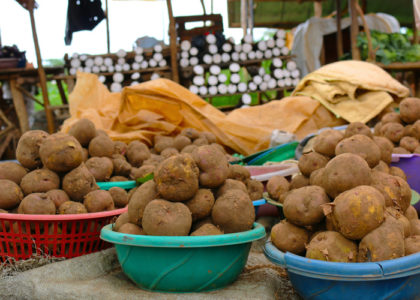
At the 19th Triennial Symposium of the International Society for Root and Tuber Crops (ISTRC) held from 21-25 November, Nairobi, Kenya, speakers and panelists at a CGIAR side event underlined the importance of root and tuber crops as shock absorbers to help transform food, land, and water systems in a climate crisis.
“Potato, sweetpotato, cassava, yam and other root and tuber crops, like taro, are the shock absorbers, the crops that increase in importance at difficult times,” said Paul Demo, Regional Director for Africa, International Potato Center (CIP) in his opening remarks.
Speaking on behalf of Claudia Sadoff, Executive Managing Director, CGIAR, Demo highlighted the contribution of the recently concluded CGIAR Research Program on Roots, Tubers, and Bananas in developing technologies through partnerships with scientists, extensionists, and farmers, pointing to production increases which have tripled to 836 million tons over the last 60 years. “We still face chronic underfunding, compared to investment in other commodities, which makes it very difficult to tackle the multiple challenges that root and tuber crops are facing” he warned, stressing the need to accelerate breeding to produce “climate-resilient, high-yielding crop varieties with higher nutritional values.”
Elizabeth Parkes, a cassava breeder from the International Institute of Tropical Agriculture (IITA) challenged the audience during her presentation to consider the need for more investment in research and innovations on root and tuber crops as a “global problem for all of us. If we don’t want to go hungry, then get on board”.
Parkes set out progress from when crops like cassava and yam were considered orphan crops. “Now we have genomic sequencing, and the seed systems are developing, including through engagement with the private sector and farmers as citizen scientists.” She also pointed out developments in the use of digital technologies such as bar codes for phenotyping but warned that “we need to speed up genetic gain – we cannot go at the speed we went 50 years ago.”
Jonathan Newby, Agricultural and Natural Resource Economist at the Alliance of Bioversity International and CIAT, focused on the importance of bringing different areas of expertise together in his presentation. “If the problem is around pests and diseases, for example, we need breeders, virologists, pathologists, seed system actors, and economists to develop solutions together. We also need to understand the drivers, such as the globalization of value chains and shocks like the Ukraine situation, and how that impacts prices and the seed systems before we get to the genetics, so we know how it all fits. This is the thinking behind CGIAR’s new Initiatives like Genetic Innovations and Resilient Agri-Food Systems.”

Dr Dinah Borus, Senior Scientist at CIP likened crops like sweetpotato to an underground bank due to their resilience to drought and other extreme weather events. “When other crops fail, sweetpotato won’t fail, including in disasters”, Borus said during the final presentation. She outlined cases for success including the accelerated breeding of climate-smart varieties like Unica, a drought-tolerant potato variety released in Kenya in 2016 that is increasingly grown there and is also gaining ground in India. Borus also highlighted the ongoing development of orange-fleshed sweet potato varieties that fill Vitamin A gaps and have future potential to target zinc and iron deficiencies.
The presentations were followed by a panel discussion moderated by Vivian Atakos, Outreach Manager, CIP/CGIAR GENDER Impact Platform who challenged the panelists on issues around raising the profile of root and tuber crops, scaling, and inclusive development.
Joyce Maru Sweetpotato Program Coordinator CIP spoke about the importance of influencing policies to make sure that when countries are thinking about their food and nutrition security, they think of root and tuber crops. “I see CGIAR funding as a catalyst but for real scaling that reaches the communities, governments need to come in through policy changes and investments,” Maru said. “We need to better communicate evidence from our research about what these crops can contribute at times of drought when other crops or livestock may fail.”
Prof Lateef Sanni, Chair, ISTRC and Professor of Food Science and Technology, Federal University of Agriculture, Abeokuta and a farmer spoke about the need to scale up through partnerships. “Speaking with my farmer hat on, we need to engage with the private sector to implement what we are promoting, yet 99% of us are not doing that, even though we may run farming businesses. For scaling up and profile raising, we need to work together across regions, and continents.”
In closing, Atakos summed up the key messages. “Locally produced and consumed, root and tuber crops are often spared the price fluctuations of internationally traded staples such as maize and wheat and offer a development pathway to improved nutrition and long-term sustainable growth for the 300 million resource-poor farmers who depend on them for their livelihoods,” Atakos concluded.
Wednesday 23 Nov 2022
ISTRC | 19th Triennial Symposium 2022 – International Society of Tropical Root Crops 19th Symposium, Nairobi, Kenya. (aatf-africa.org)
